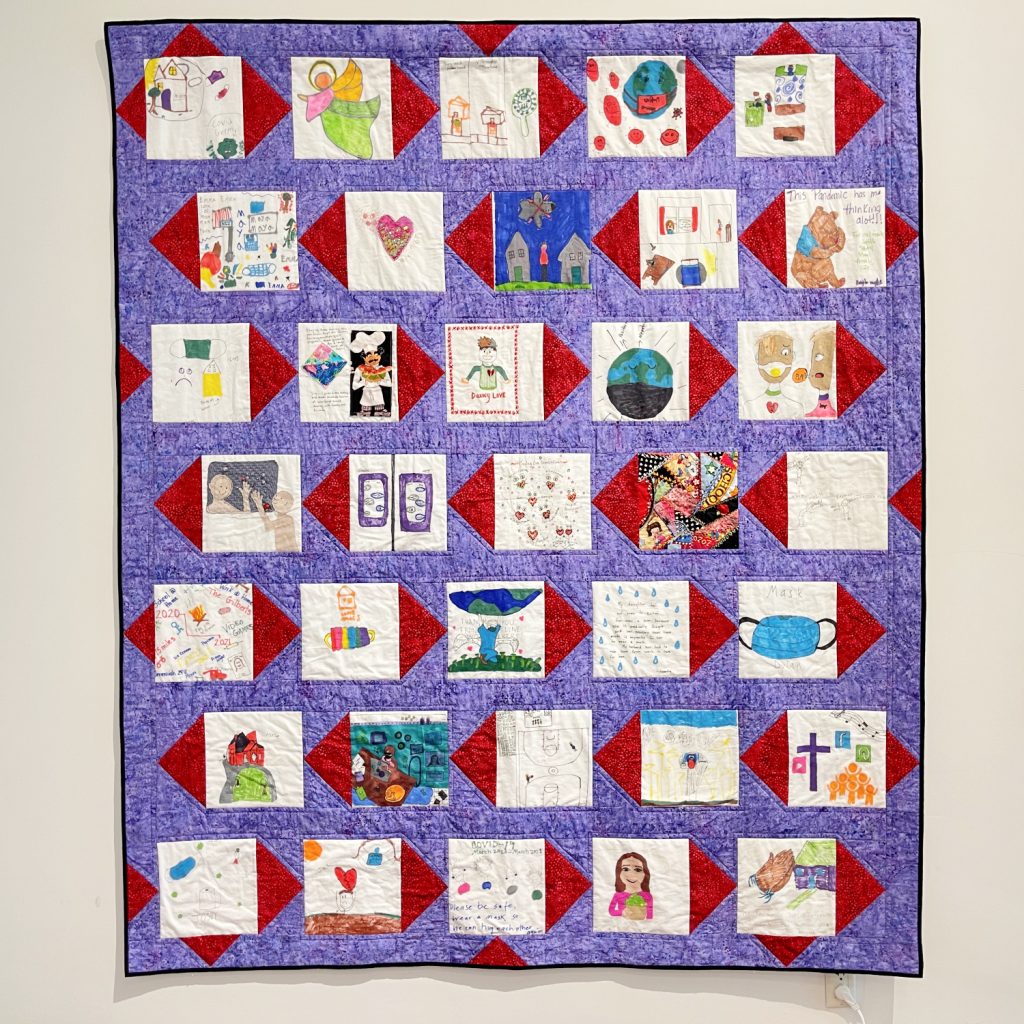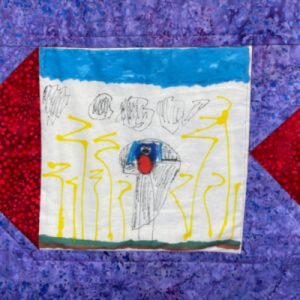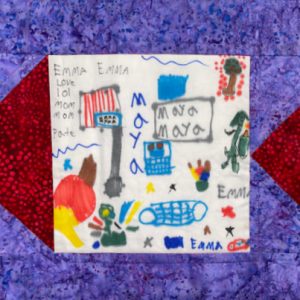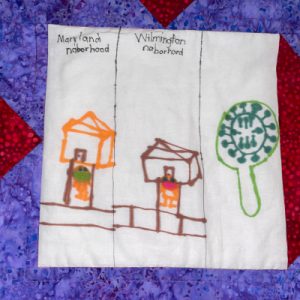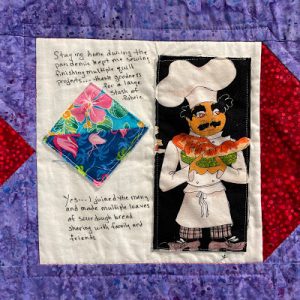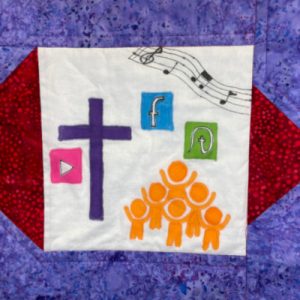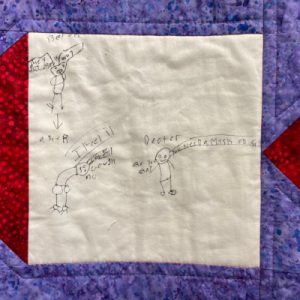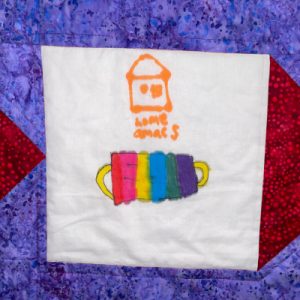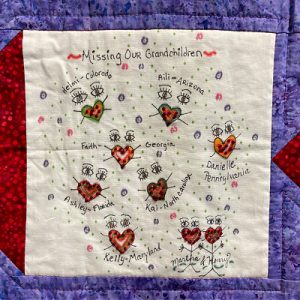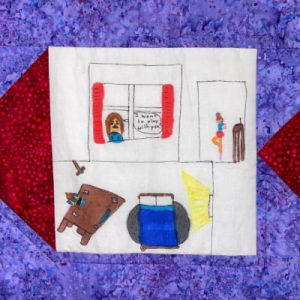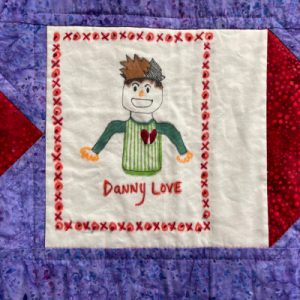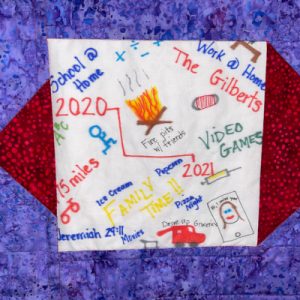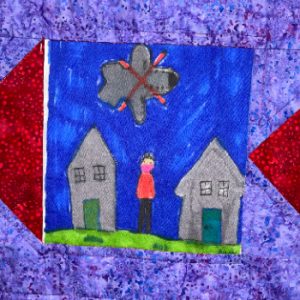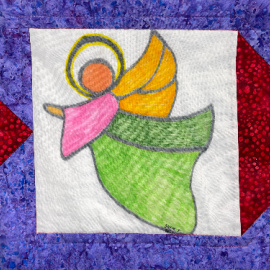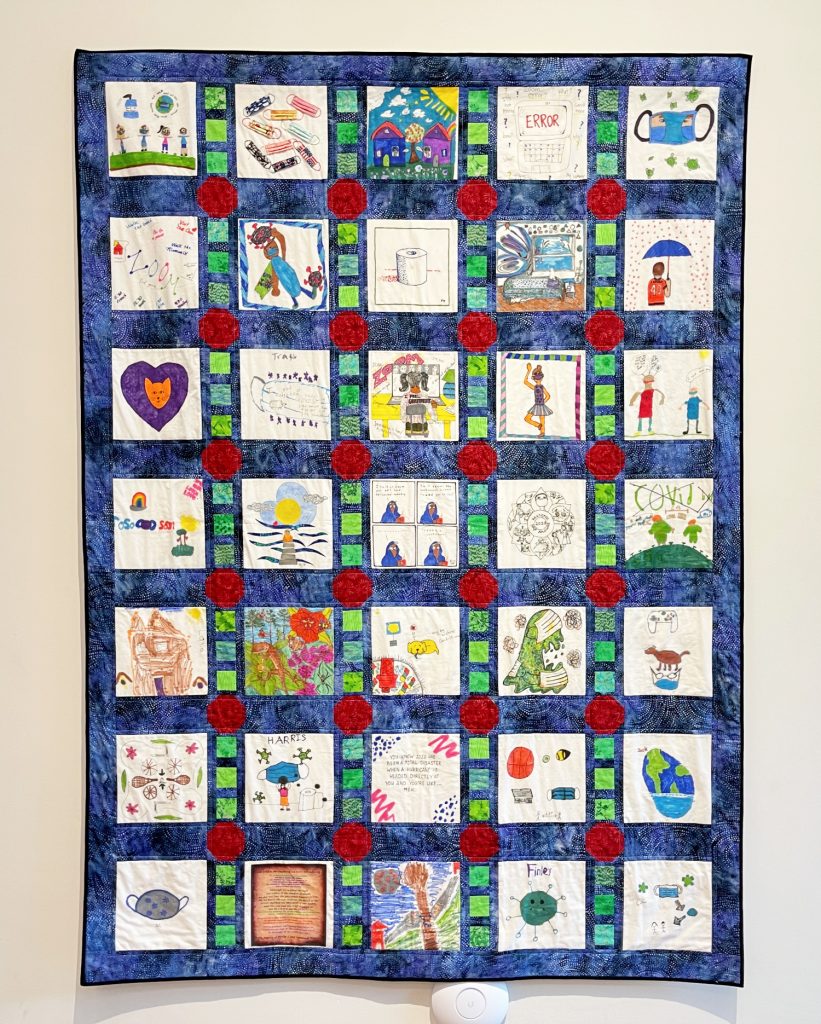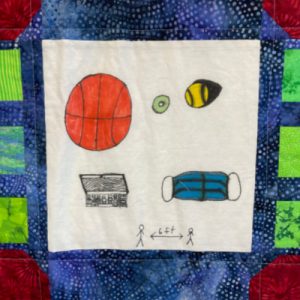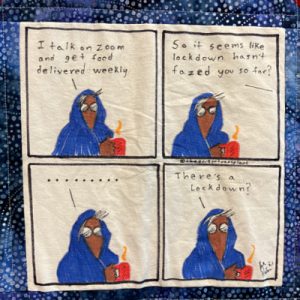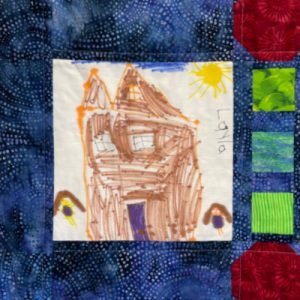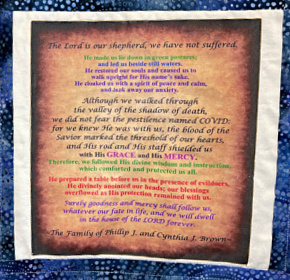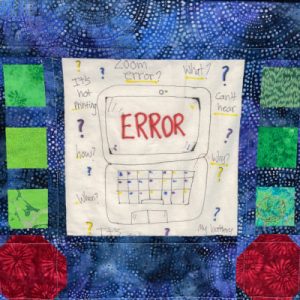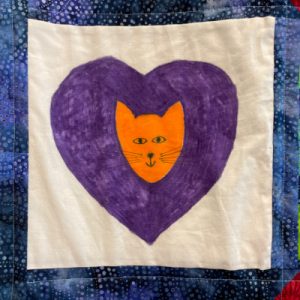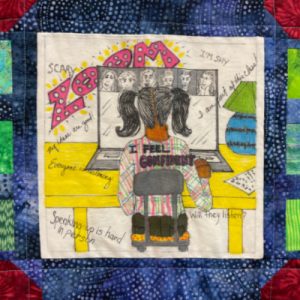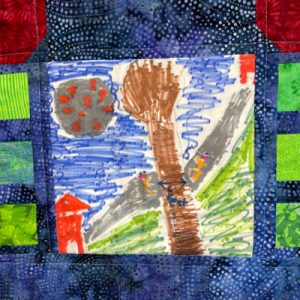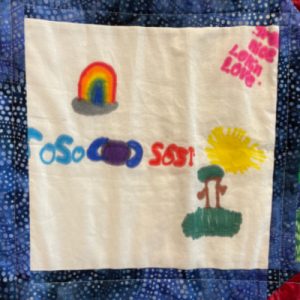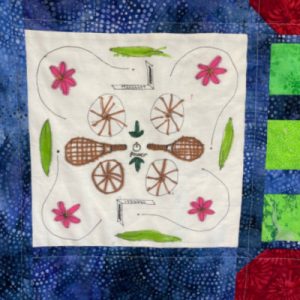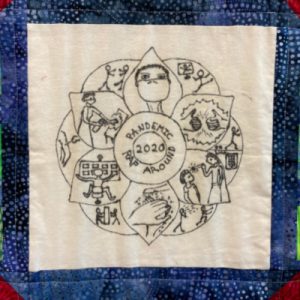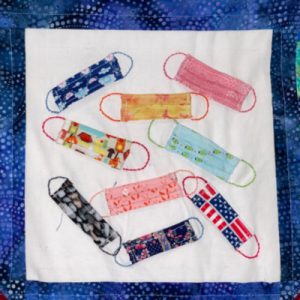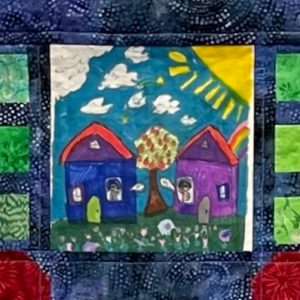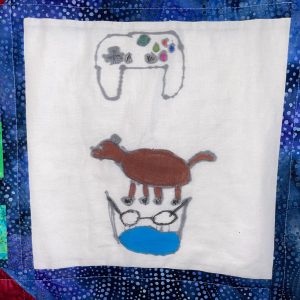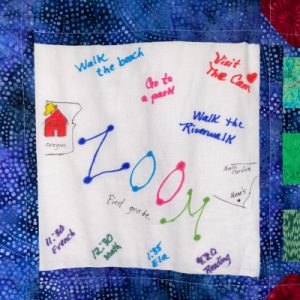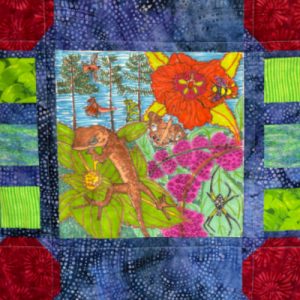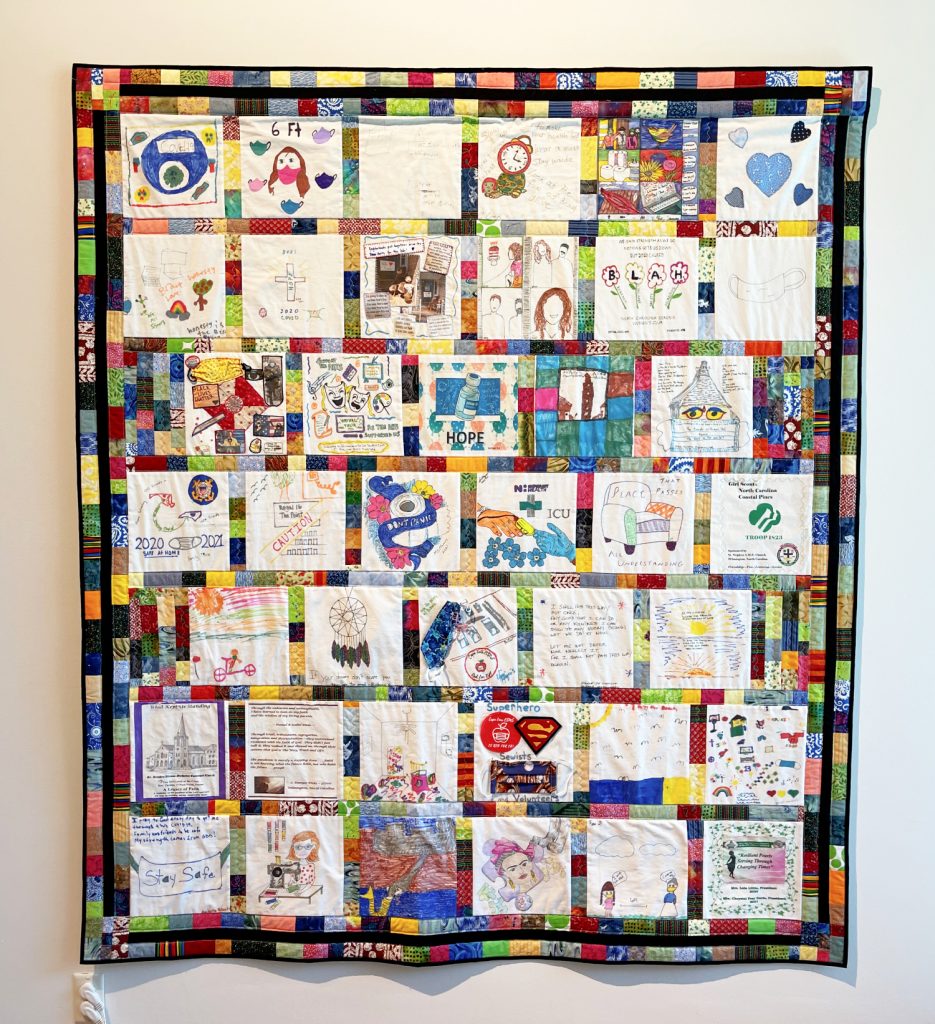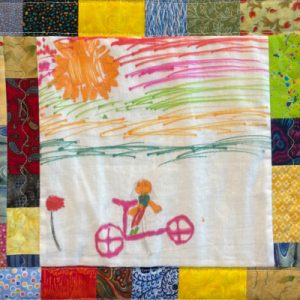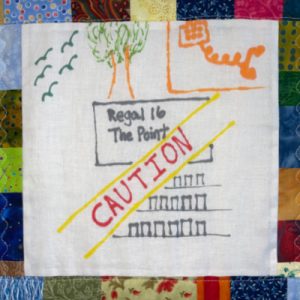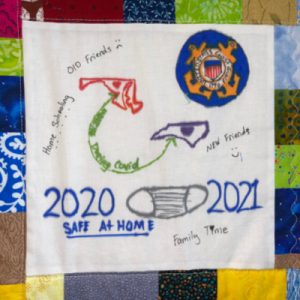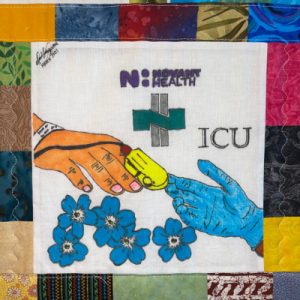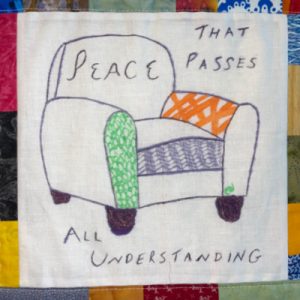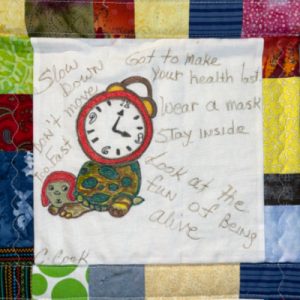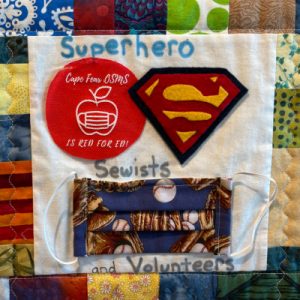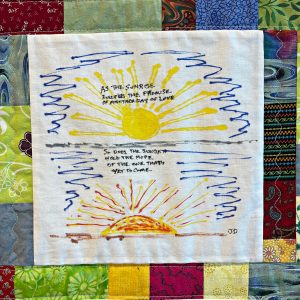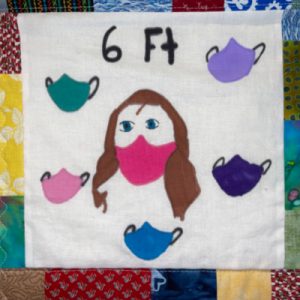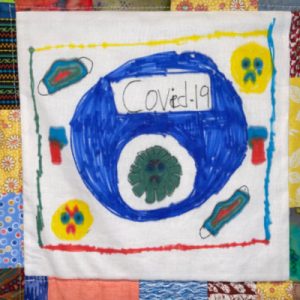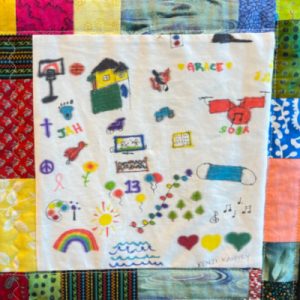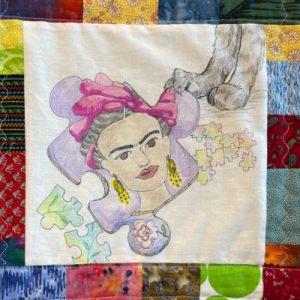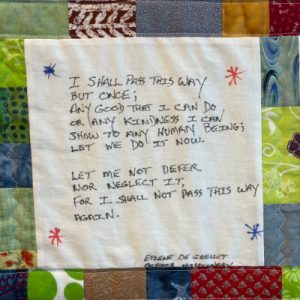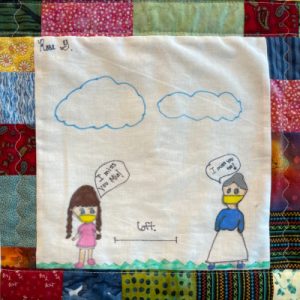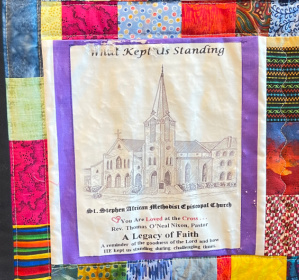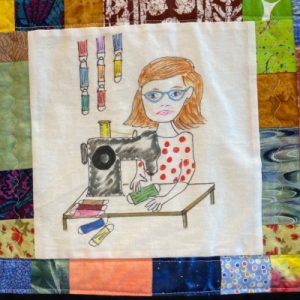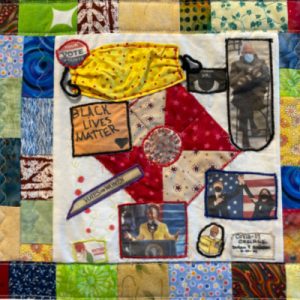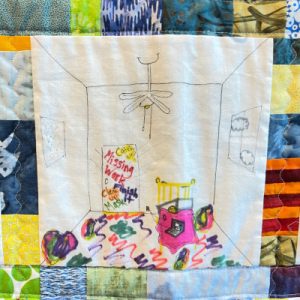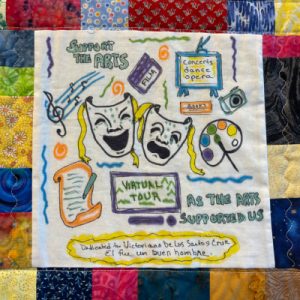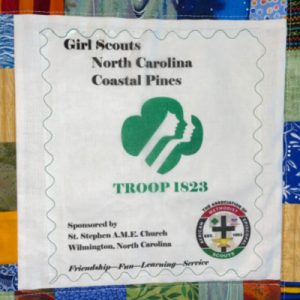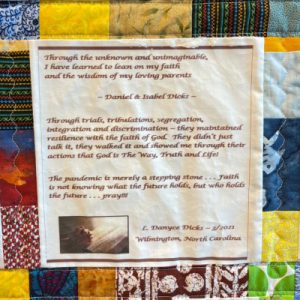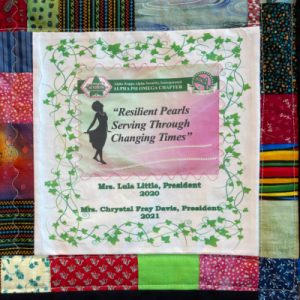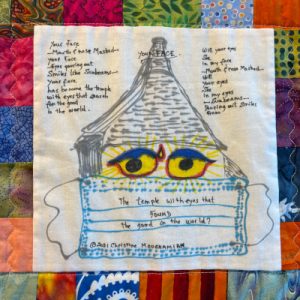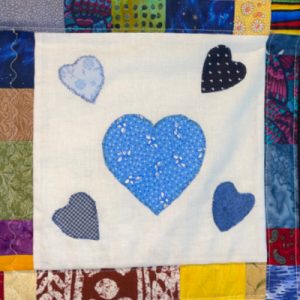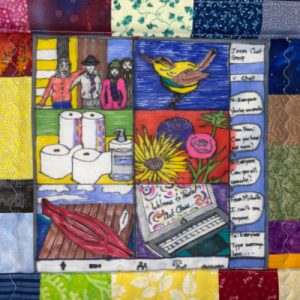The Wilmington COVID Quilts
Background
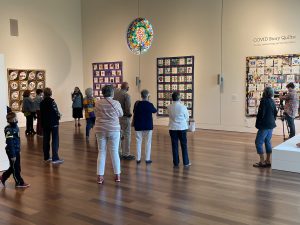 The three quilts featured in these pages were produced as part of a global program by AP to allow people a creative outlet for their frustrations during the pandemic and lock-down. The program was launched in the late spring of 2020 and has generated over 200 powerful stories from the US, Kenya, Nepal and Zimbabwe as of writing (July 2021). With no end in sight to the pandemic, and infections rising in the Global South, we are still inviting submissions.
The three quilts featured in these pages were produced as part of a global program by AP to allow people a creative outlet for their frustrations during the pandemic and lock-down. The program was launched in the late spring of 2020 and has generated over 200 powerful stories from the US, Kenya, Nepal and Zimbabwe as of writing (July 2021). With no end in sight to the pandemic, and infections rising in the Global South, we are still inviting submissions.
These quilts were made from 109 personal stories that were painted or sewn onto fabric by friends of the Cameron Art Museum in Wilmington, North Carolina during the Fall of 2020 and early 2021. AP contributed $500 to offset some of the cost. The project was initiated by Bobbi Fitzsimmons, who coordinates AP’s quilting program and is active at the Museum. It was managed by Heather Wilson, deputy director at the Museum and by Georgia Mastroieni, Director of Outreach and Family Engagement.
Bobbi and Georgia put out the word in late 2020 and were surprised and delighted by the response. They then sent out packages with basic material (fabric and magic marker) to everyone who had applied. Bobbi assembled the stories into the three quilts in March and April.
The quilts capture the full range of emotions caused by the pandemic and indeed may serve as something of a time capsule in years to come. Connie Moser produced a simple blue heart in memory of her mother who passed away one day after being diagnosed with COVID. “Blue was her favorite color and many people feel very blue without her” she says.
Dr Kyle Horton used her block to celebrate the remarkable work of Open Source, a network of volunteer mask-makers in the Cape Fear area who produced an astounding 10,000 facemasks for use at medical centers during the height of the pandemic.
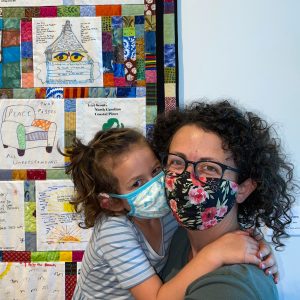 Sadie Thomas, 5, and her mother Dorothy (photo) used their block to describe their disappointment when Sadie’s 4th birthday party had to be cancelled and replaced by yet another Zoom meeting. They painted four candles and pictures of their Zoom invitees with blank faces. “We turned off the computer and it was just us,” says Dorothy.
Sadie Thomas, 5, and her mother Dorothy (photo) used their block to describe their disappointment when Sadie’s 4th birthday party had to be cancelled and replaced by yet another Zoom meeting. They painted four candles and pictures of their Zoom invitees with blank faces. “We turned off the computer and it was just us,” says Dorothy.
Fritzi Huber, who is active at the Museum and has been making paper for over 40 years, depicted a toilet roll to remind herself of that time when the shelves were almost empty. She sees a silver lining in the pandemic: as well as causing tragedy for many, COVID-19 provided her with a license to hole up and pursue her passion.
Jean Lozada, originally from Venezuela, also works at the museum and used his block to create a “Mask Monster” in protest against the number of facemasks that are abandoned, creating a possible health hazard.
About 50 artists submitted captions, and none was more moving that the one from Amanda Cummings a nurse who treated many COVID patients at the local hospital and witnessed much suffering during the pandemic. Amanda used her design to describe the intense relationship between a sick patient and a nurse, and included a poem: “Patient: Forget me not; tell my family that I love them. Nurse: I will forget you not; I will hug my family a little tighter tonight. Patient: Thank you for all that you do. Nurse: I’m sorry I couldn’t do more. Family: They sent flowers for the memorial… they were Forget Me Nots.”
AP has interviewed several artists and all said that it had made them feel better to describe their feelings through painting and see their story featured alongside that of other pandemic sufferers. “We are really thankful to be able to make something that expresses what we went through,” said Dorothy. “It is kind of cathartic to look back at the picture and be like ‘Oh my gosh!’”
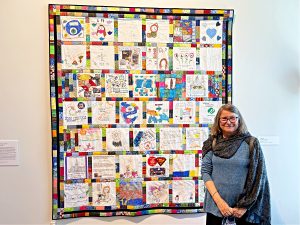 Bobbi Fitzsimmons, who inspired the project, agreed wholeheartedly. The pandemic struck North Carolina in March 2021 soon after Bobbi returned from a trip to Asia, and she found the sudden isolation deeply disturbing. But Bobbi is an expert quilter and after getting over the shock she began making masks, for nursing homes, friends and Dr Horton’s Open Source network of volunteer mask-makers.
Bobbi Fitzsimmons, who inspired the project, agreed wholeheartedly. The pandemic struck North Carolina in March 2021 soon after Bobbi returned from a trip to Asia, and she found the sudden isolation deeply disturbing. But Bobbi is an expert quilter and after getting over the shock she began making masks, for nursing homes, friends and Dr Horton’s Open Source network of volunteer mask-makers.
So far Bobbi has made over 1,300 masks and asked her clients to show their gratitude by donating to good causes. “Sewing these masks gave me the purpose I needed to make me feel less helpless in the face of this pervasive enemy. Sewing these face masks gave me hope.”
The three Wilmington quilts were shown at the Cameron Art Museum on April 22 alongside the quilts from Zimbabwe, Nepal and Arlington and the event attracted a good turnout of local friends, including several artists. Anne Watson, who assembled the Nepal COVID quilt and herself came down with COVID at Christmas, spoke movingly about the expert medical care she had received – in stark contrast to the lack of facilities available in Nepal. Prabal Thapa, a Nepali Peace Fellow who has been working remotely for AP’s partners in Nepal from the US while his country struggles with a new lock-down, also attended.
Other visitors included Stephanie, Layla, Kate and Natalie from the Wakefield High School in Arlington Virginia. All four had contributed wonderful stories to The Arlington COVID quilt and enjoyed their first trip away from home in over a year. Layla and Stephanie – the two Wakefield coordinators – opened the event with a polished address.
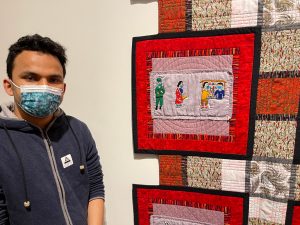 The exhibition attracted local press coverage before and after. AP publicized the event through a news bulletin and during the first-ever digital exhibition of quilts, held on June 3. The event attracted over 90 visitors. AP has also produced a collage of video interviews with several artists and will include the Wilmington quilts in a catalogue of COVID stories later in the year.
The exhibition attracted local press coverage before and after. AP publicized the event through a news bulletin and during the first-ever digital exhibition of quilts, held on June 3. The event attracted over 90 visitors. AP has also produced a collage of video interviews with several artists and will include the Wilmington quilts in a catalogue of COVID stories later in the year.
The Wilmington exhibition was the first time that all COVID quilts could be physically displayed and marked a fitting end to the long months of lockdown and isolation. “What a nice way to welcome the spring!” said one visitor. “It could not have come sooner….”
The exhibition also underscored the importance of the Cameron Museum in raising morale during the dark months. The Museum stayed open throughout the pandemic, albeit with a greatly reduced staff, and organizers agreed that the COVID quilt project had given the Museum and its members a focus and something to look forward to. It was one more sign that museums are at the heart of community life. AP is proud to have helped.
First Quilt
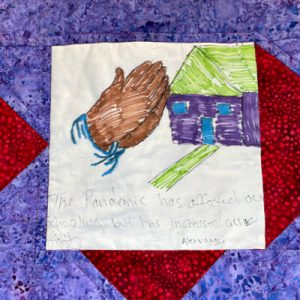 |
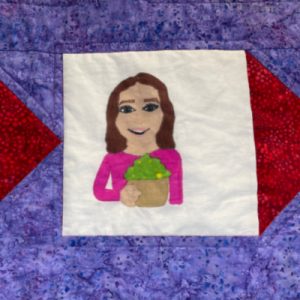 |
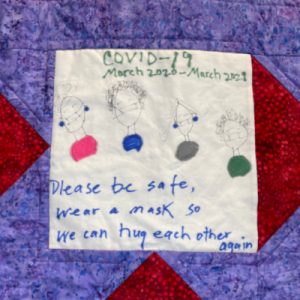 |
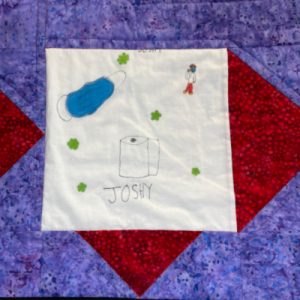 |
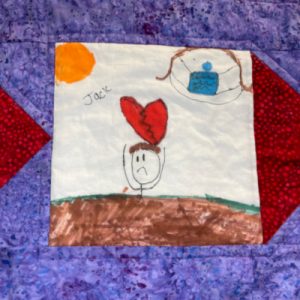 |
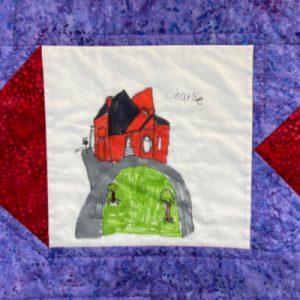 |
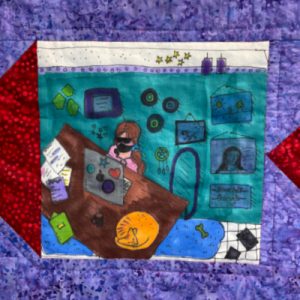 |
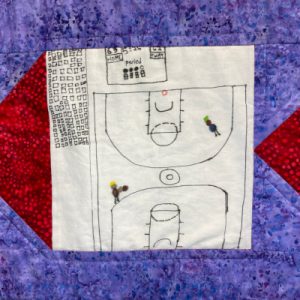 |
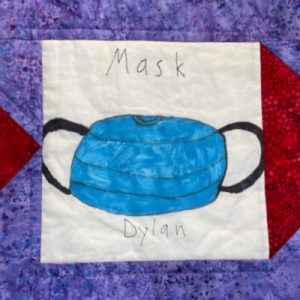 |
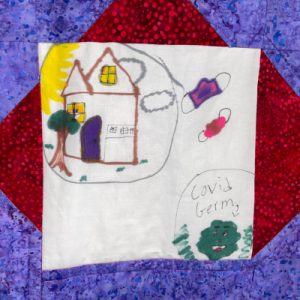 |
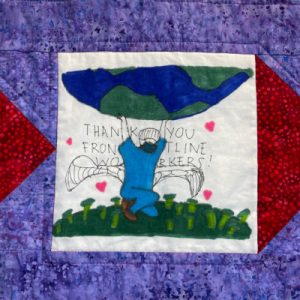 |
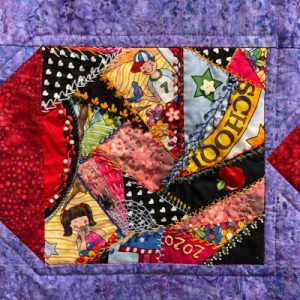 |
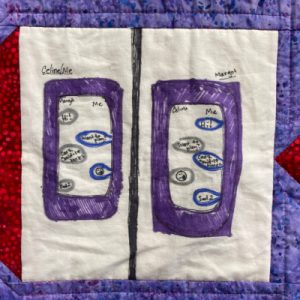 |
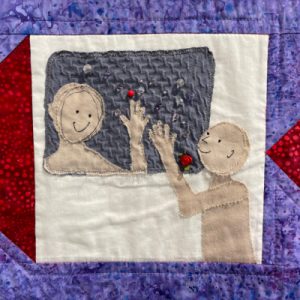 |
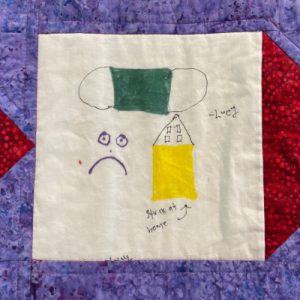 |
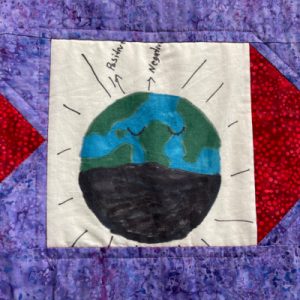 |
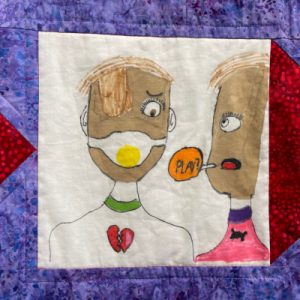 |
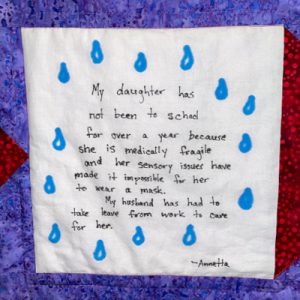 |
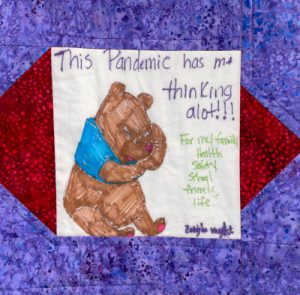 |
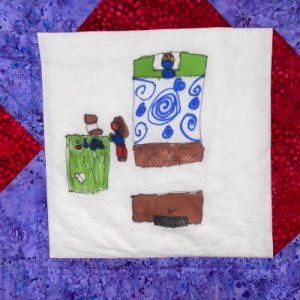 |
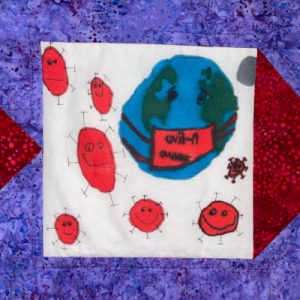 |
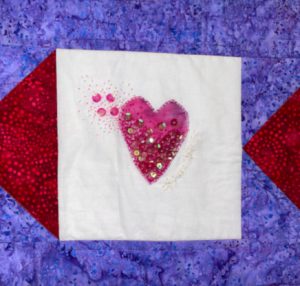 |
Second Quilt
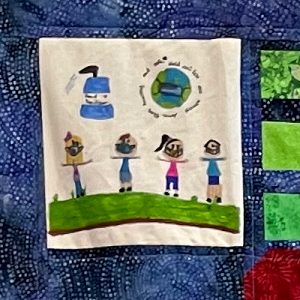 |
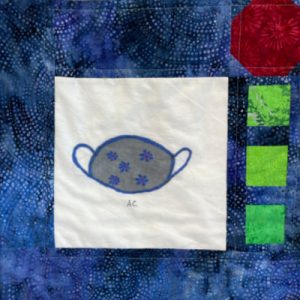 |
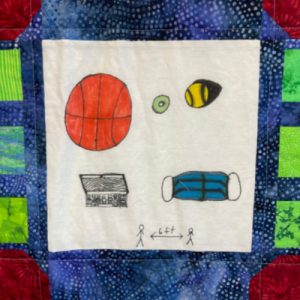 |
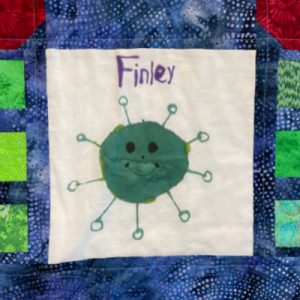 |
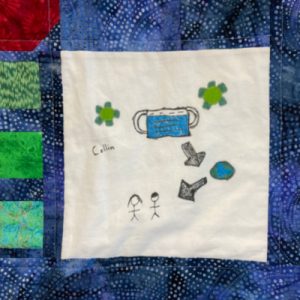 |
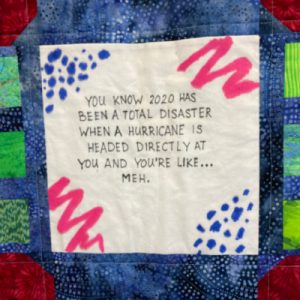 |
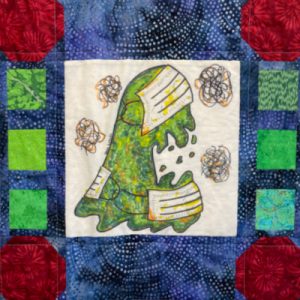 |
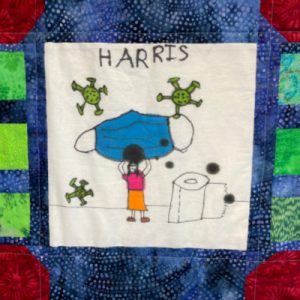 |
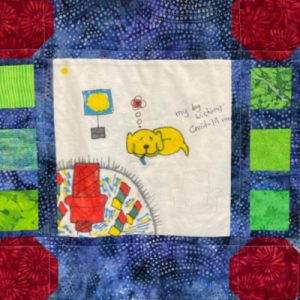 |
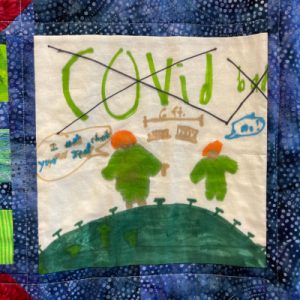 |
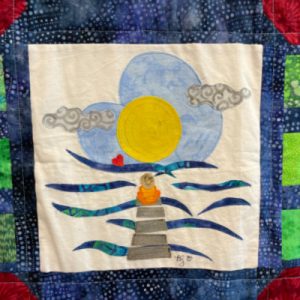 |
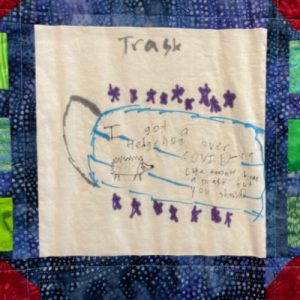 |
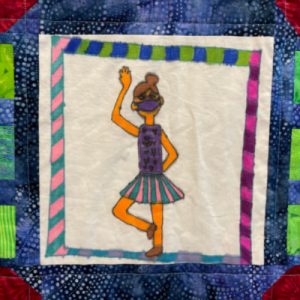 |
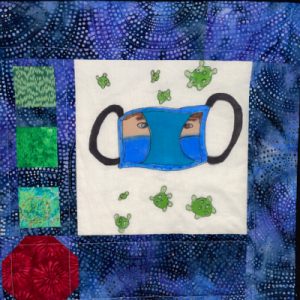 |
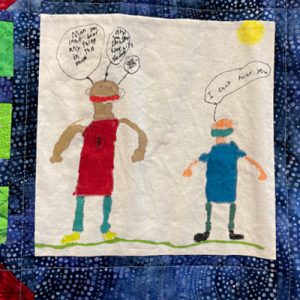 |
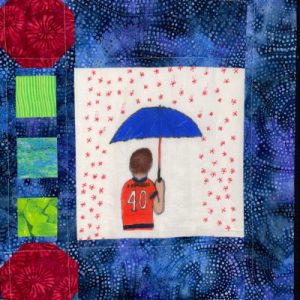 |
|
Today I awaken to the song of a solitary chickadee. Every day there’s so much, the more you look and listen, in one place, a world can open up to you, reveal itself, teach you, give you beauty, provide healing, and create companionship with life in so many forms. It’s all there; growth, change, injury and renewal, and sometimes heartbreak and grief. This year has developed my awareness and reverence for the natural world just outside the window. I’ve watched house finches successfully raise a group of siblings, excitedly chippering around, revisiting the nest they built on the platform outside the birdhouse (because bees were living within), only to see another group of 3 fledglings and parents disappear in the night. That one was really hard. They nested on the makeshift platform I made, close to the front door, and I checked on their progress every morning on my way to make coffee. Joy, then silence, emptiness. In my relative solitude, that family had become my immediate family. For a few days, I refused to believe they were gone – fledglings too young to have flown away – but didn’t want to get too close to the nest, as the mother was hyper-protective, actively deflecting any interest, including that of other finches. I blamed myself for not creating a secure enclosure for the nest. It took a long time for me to come to terms with the metaphor here, of the cycles of life, of something dying to feed the life of another, of ecology and the balance of nature, of not having control, or acceptance, of appreciating beauty, love, happiness, when you know it, when you have it because we never know how long it will last. And when we have to let it go, let it go with gratitude for what was. Watching the changes in spring, autumn, winter, and now spring again, and the rhythm in this, I found solace in such a variety of hard-working survivors, survivors because the natural world can really teach about how quickly things can change. Throughout all the emotional challenges of this year, not only the pandemic but also the struggle to reach a more just equilibrium in society. I could practice orienting myself to be in the present moment with the help of the natural world I was lucky enough to walk out into. This privilege has come into high relief, as so many survivors this year in cramped spaces, without such a view out their windows, without the ability to simply step out the door and into a small patch of nature, perhaps going to jobs that endangered them daily. The disparities in terms of access to such spaces and to simple necessities like a real grocery store in the neighborhood, safe workplaces, and access to health care, need to be acknowledged and rectified. In the smaller scope of one lifetime, I’ve found 2020, etc skills to be the tools to manage the depression and anxiety that have been my demons, my lessons to learn. So, yes, I am grateful for this year, and I hope the upheaval can be fodder for healing and growth, in the micro-and macrocosm My square contains a fraction of friends and teachers, a baby Carolina Anole on mint leaves (so small), Beauty Berry bushes with an Orb-weaver spider, a Buckeye Butterfly, a just-blooming Texas Star Hibiscus with a Bumble Bee, Long Lead Pines, a Praying Mantis, and a male Baltimore Oriole and female Cardinal. I’m thankful for this opportunity to share the love, because of what the world needs need now… |
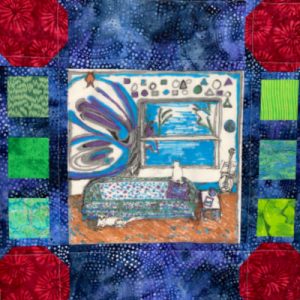 |
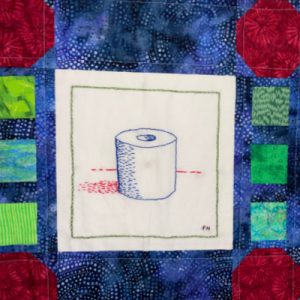 |
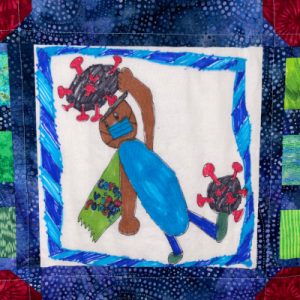 |
Third Quilt
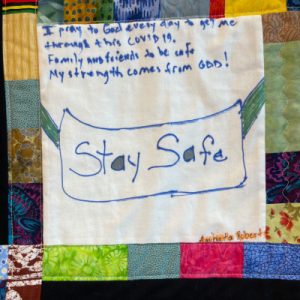 |
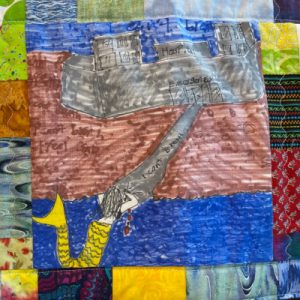 |
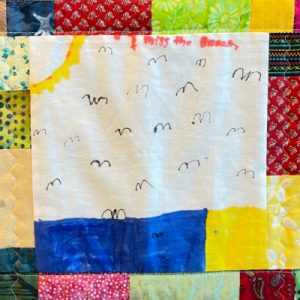 |
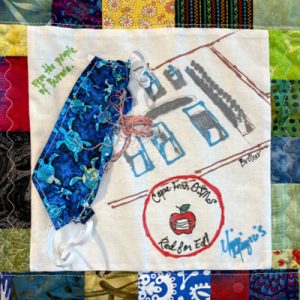 |
|
Strength, balance, courage, flexibility, creativity, resiliency, gratitude and healing are all things that come to mind when we reflect on the year of the pandemic. Everyone has experienced a great deal of loss in so many ways. But one of the ways we have discovered is that the things we have lost, are also the things that we are most thankful for and the things that we find comfort in when trying to move forward. One of the things we found that we missed the most was sports as we knew it. We missed watching it on TV and in a stadium and playing together with friends. But we soon found new ways to enjoy it and focus on practicing and developing new skills so that when we are able to come together and play again, we can be a better teammate. Live music and concerts as we knew it changed overnight. Over the summer months especially we felt this loss tremendously. The joy and healing that it brought took a toll. But we were able to find new ways to experience the vibes that we loved. We used this time to learn to play new instruments, explore new talents, discover new artists and listen intently to lyrics to find meaning and resolution like a unique dorm of Therapy. We missed hanging out with friends, going to shows and the theatre, festivals and events. Simple things like going out to dinner or attending a community gathering were a luxury we no longer had. But we soon discovered new ways to enjoy the company of others, celebrate milestones, and work from home. Zoom was our new best friend and drive-by parades were happy times. We visited with neighbors from our porch engaging in loud conversations across the yard. We used the extra time we now had to plant vegetable gardens, finish projects at home, nurture our creativity and really get to know our family members that we were lucky enough to live with. We played games, we read books, we watched movies and documentaries, we experimented in cooking new recipes, we painted and colored and did crafts, and we talked and listened more. Time was a new gift we had been given. Time was also a thief as we began to contend with the real fear of losing someone you loved. As time marched on, there was almost no one that wasn’t somehow impacted by someone who has experienced a glimpse of COVID. The reality. |
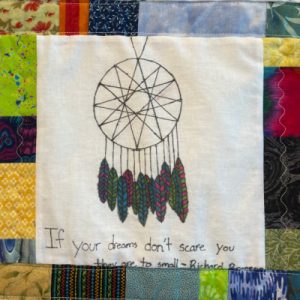 |
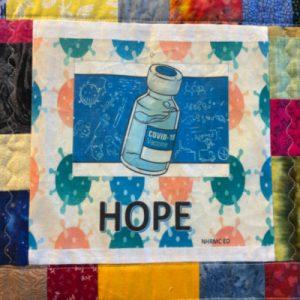 |
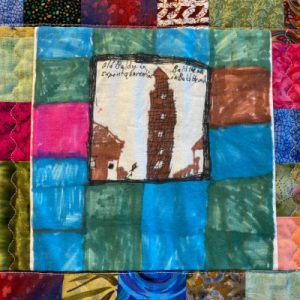 |
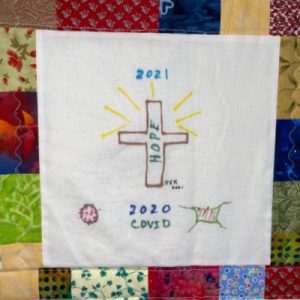 |
|
On March 13, 2020, I returned to the US from a three-week trip to Southeast Asia to find a very different world. Borders were closing, schools were closing, stores, and restaurants, and theaters were closing. Many of us were afraid of this new, unseen enemy – COVID 19. For the first two weeks home, I voluntarily isolated because of my travels. I didn’t leave my house. Friends left food on my front porch. All further trips planned for 2020 were canceled. My family was suddenly out of reach and I didn’t know for how long. It would have been so easy to just Retreat. But I needed a purpose and I quickly found it in making face masks. Face masks, like many other things to help us contain the virus, were clearly in short supply. But I had fabric and I had time. So, I began to sew, not sure where I’d find takers for my masks. The first ones I donated to Trinity Grove nursing home, to the people who had taken such good care of my husband during his last months. I gave them to friends, and friends began asking for more to give to other friends. I discovered Open Source Medical Suppliers and realized just how great the need really was. I sat at my sewing machine for a couple of hours each day and made masks that were donated to schools, doctor’s offices, nursing homes, and underserved communities. As of this writing, I’ve made over 1,300 masks – never taking a penny for them, just asking those who could pay it forward. These little fabric face masks provided benefits to many. They provided a level of safety to frontline workers, they showed people that there were those who cared, they created new friendships as OSMS sewists met online for regular meetings. Most of all, sewing these masks gave me the purpose I needed to make me feel less helpless in the face of this pervasive enemy. Sewing these face masks gave me hope. Now, along with so many members of the Wilmington community, I’ve created these Pandemic Story Quilts to remind us that we have been through a life-changing experience. In the experience, we have felt sadness, grief, and loss. But we’ve also found humor, strength, and perseverance. We are resilient. Life will get better and we will have learned from this experience. I know I have. |
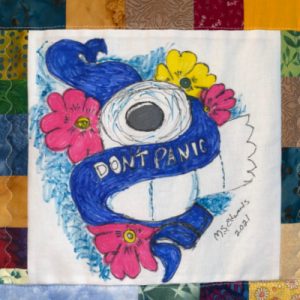 |
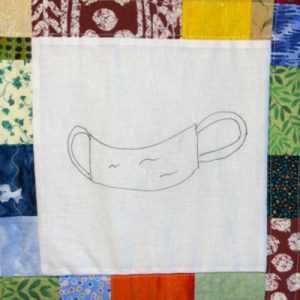 |
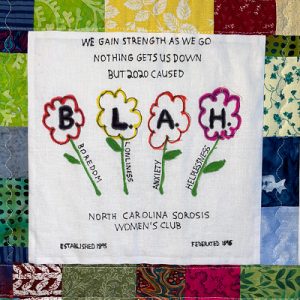 |
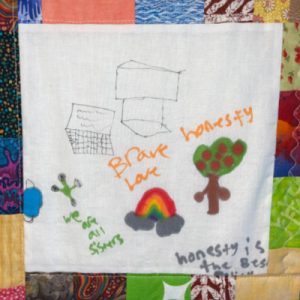 |
|
The panic set in during the first quarantine. Prior to that, I kept up with the news about the growing spread of the Coronavirus, but had doubts when a friend in Seattle told me there was talk of shutting the entire city down. How could that ever happen in a place where everyone is in constant motion? And then it did. There is Seattle, here in North Carolina, and everywhere in between. A monster was on the loose, far worse than anything we had been exposed to during this lifetime. A ruthless killer with no set pattern that attacked without warning. We were told to wait it out; it would be over soon. But it only got worse. Soon, the numbers of the dead became names, and the names became those of people I knew. Of those people, most eventually recovered, some are now known as “long-timers” – those who still have lingering issues, and some are now Covid-19 mortality statistics. One of the most difficult losses was a master carpenter who became a family friend as her built a new fence around our backyard to replace the old one destroyed by hurricane Florence. He also built the Little Free Library I have in front of my home – using reclaimed wood because he preferred to recycle and repurpose things to help our earth. Our friend became ill with Covid-19 and was hospitalized. Less than a week later, he took a turn for the worse and died. He was a kind and gentle soul. Throughout this time of uncertainty, loss, fear, and sorrow, the silver lining for me has been the arts. Arts programs nationwide have always topped the chopping block when budget cuts loomed in schools, in local, state, and national funds distribution, and whenever something needed to go. Yet, it was the Arts that stepped up to help a grieving world cope. Instead of shutting the world down, the Arts brought us together. We are treated to free nightly opera performances at the Met, Broadway shows, ballet and dance programs, concerts, virtual tours of museums, historical sites, and the world. We can take online classes and workshops. Major film festivals and Arts conferences became accessible to all. The Arts have been taking our minds off what we can’t do and giving us back so much more. Please remember this when things eventually turn around. Support the Arts the way they support us now. My quilt square is dedicated to the memory of Victoriano De Los Santos Cruz. El fue un buen hombre. |
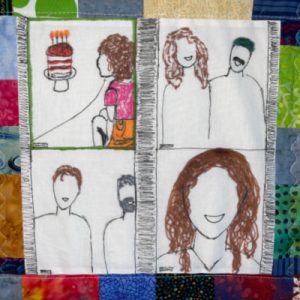 |
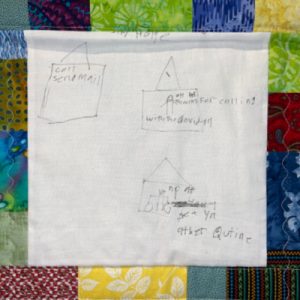 |
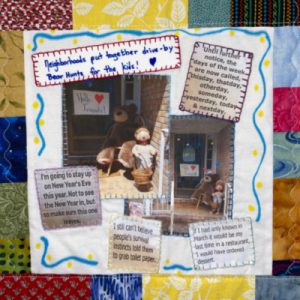 |

